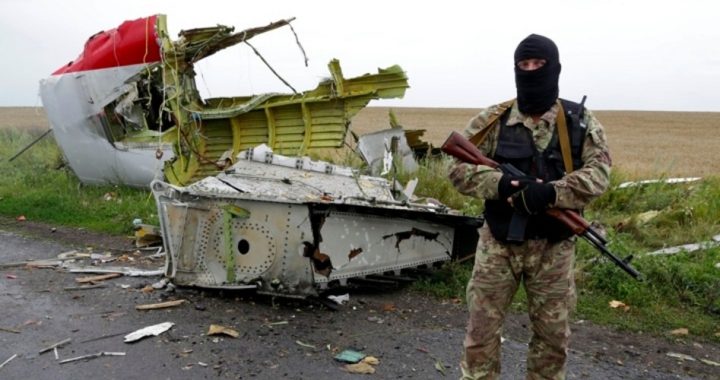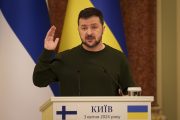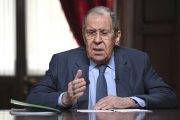
The tragedy of the civil war that has raged in Ukraine’s eastern regions for the past several months spilled out far beyond the borders of that nation on July 17 when 298 passengers and crew of Malaysia Airlines Flight 17 (MH 17) were murdered by an anti-aircraft missile fired from within the contested region.
As previously reported for The New American, the Putin regime has been threatening Ukraine in recent days that there would be “irreversible consequences” for a single Ukrainian artillery shell that crossed over the Russian border, allegedly killing one individual and wounding several others. In the aftermath of the declaration of “irreversible consequences,” there appears to have been a significant escalation in direct Russian involvement in the crisis.
Michael Weiss, writing for Foreign Policy on July 16, reported that recent video evidence showed that Russian missile systems were being moved into Ukraine and operated by Russian crews; in the words of Weiss, the video constituted the “most definitive proof yet of Moscow’s direct participation in the ongoing war in eastern and southern Ukraine: Russian rockets being fired toward Ukraine.” Weiss alleged that what had been observed were BM-21 Grad rocket launchers, “Soviet-designed, multiple-launch rocket system mounted to a truck, capable of firing unguided rockets with a range of 12-27 miles, depending on the particular rocket used.”
The BM-21 Grad is fundamentally different from the Buk M-1 system that was allegedly used to shoot down MH 17 — the BM-21 Grad is used against targets on the ground, while the Buk is used for air defense — but the allegation of the movement of major weapon systems across the border would indicate the possibility of a recent, substantial escalation of the conflict by the Russians. Furthermore, the BBC reported on the morning of July 17 that rebels were claiming to have shot down two Ukrainian fighter jets — a development that, in the words of the BBC’s Daniel Sandford, could signal a significant escalation: “If Russia has indeed shot down a Ukrainian fighter jet over Ukrainian territory, it would be a significant escalation of this conflict, showing the Russian military openly engaging Kiev’s forces.”
At 5:15 p.m. local time (14:15 GMT) on July 17, Ukrainian authorities notified Malaysia Airlines officials that Flight 17 had vanished from radar; less than half an hour later, at 5:37 p.m., Igor Strelkov, the commander of the armed forces of the so-called Donetsk People’s Republic, took credit for the attack, declaring “In the area of Snizhne just shot down the AN-26” and minutes later recorded that the “‘Bird’ fell in waste heap, the residential sector is not caught. Civilians are not injured. And also have information about the second downed aircraft.”
After it became apparent that it was a Boeing 777 that had been shot down, Strelkov apparently deleted his previous comments claiming credit for the destruction of MH 17. However, the Internet “Wayback Machine” archived Strelkov’s posts — no doubt to the profound embarrassment of Strelkov and his allies.
The Ukrainian government also claims to have successfully captured a phone conversation between Igor Bezler (identified by the Ukrainian secret service as a Russian military intelligence officer), Vasili Geranin (identified as a colonel in the GRU — the intelligence division of the Russian armed forces), and Cossack commander Nikolay Kozitsin. The transcript, released by the Ukrainian government, quotes Bezler as declaring: “We have just shot down a plane. Group Minera. It fell down beyond Yenakievo (Donetsk Oblast).” The transcript also alleges that after 40 minutes the rebels began to realize that what they had shot down was a civilian plane:
“Major”: The plane fell apart in the air. In the area of Petropavlovskaya mine. The first “200” (code word for dead person). We have found the first “200”. A Civilian.
“Greek”: Well, what do you have there?
“Major”: In short, it was 100 percent a passenger [civilian] aircraft….
“Greek”: Is there anything left of the weapon?
“Major”: Absolutely nothing. Civilian items, medicinal stuff, towels, toilet paper.
“Greek”: Are there documents?
“Major”: Yes, of one Indonesian student. From a university in Thompson.
The transcript provide by the Ukrainian government also alleges that, when Kozitsin learned of the attack on a civilian plane, he callously dismissed the victims as “spies”:
Militant: Regarding the plane shot down in the area of Snizhne-Torez. It’s a civilian one. Fell down near Grabove. There are lots of corpses of women and children. The Cossacks are out there looking at all this.
They say on TV it’s AN-26 transport plane, but they say it’s written Malaysia Airlines on the plane. What was it doing on Ukraine’s territory?
Nikolay Kozitsin: That means they were carrying spies. They shouldn’t be f***ing flying. There is a war going on.
As this is being written, little has been done to secure the evidence needed for an investigation of the downing of MH 17, or even to show basic human decency toward the deceased. (CNN reported on July 19 that “two days after the jet crashed, some bodies remained strapped in seat belts — wearing inflight headphones.”)
Strelkov’s “soldiers” are keeping investigators from even being able to meaningfully investigate the site of the crash. CNN reported that investigators from the Organization of Cooperation and Safety in Europe — an entity in which both the Russian Federation and Ukraine are members — discovered that the rebels had no intention of cooperating with their investigation:
A delegation of 21 monitors from the Organization of Cooperation and Safety in Europe made it in after assurances from rebel leaders, but local militiamen at the site allowed them only a brief view of a small outtake of the crash site.
“It basically looks like the biggest crime scene in the world right now, guarded by a bunch of guys in uniform with heavy firepower who are quite inhospitable,” said OSCE spokesman Michael Bociurkiw.
They asked militiamen for their commander, their leader, he said. “No one showed up.”
An armed man who appeared to have been drinking was there, Bociurkiw said, but he wasn’t helpful. “He kind of rushed all of them away, including the journalists.”
Efforts to block access for investigators to approach the crash scene, when combined with evidence that the leadership of the “army” of the Donetsk Peoples Republic claimed responsibility for the attack on MH 17 (and then apparently hastily deleting that claim) would seem to point toward the rebels being the party most directly responsible for the death of 298 civilians.
In the words of Australian Prime Minister Tony Abbott: “Quite possibly there are attempts in place to sanitise the site. The site needs to be secure. The investigation needs to take place. And frankly anyone who tries to obstruct this is no friend of justice, is no friend of peace.”
Russian authorities continue to deny responsibility for the attack. However, efforts by the Russia Today (RT) network to shift blame to the Ukrainian government led another reporter for that network, Sara Firth, to resign her position with the network. As she told The Guardian: “It was the most shockingly obvious misinformation and it got to the point where I couldn’t defend it any more.” In March, Liz Wahl resigned from her position with RT, declaring she “could not be part of a network funded by the Russian government that whitewashed the actions of Putin.”
The photo shows a pro-Russian fighter guarding the crash site of Malaysia Airlines Flight 17: AP Images



